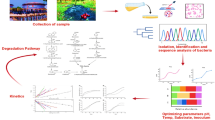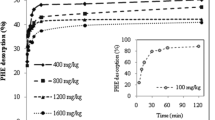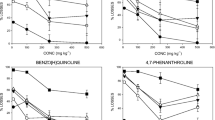Abstract
Polycyclic aromatic hydrocarbons (PAHs) are ubiquitous contaminants in the soil environment, and considered to be hazardous due to their toxic and carcinogenic properties. Intermediates accumulation during PAHs degradation significantly alters the overall biodegradation rate and toxicity of the soil environment. The biodegradation pathway of phenanthrene, a 3-ring PAH, consisting of 14 enzymatic steps was analyzed to determine the release pattern of the intermediates by mathematical calculation of permeability using a membrane transport model. The intermediates with high permeability such as 1-hydroxy-2-naphthoic acid were consistent with the compounds frequently observed in laboratory or field in the literature.
Similar content being viewed by others
References
Adachi, K., Iwabuchi, T., Sano, H. and Harayama, S., “Structure of the ring cleavage product of 1-hydroxy-2-naphthoate, an intermediate of the phenanthrene-degradative pathway of Nocardioides sp. strain KP7,”J. Bacteriol.,181, 757 (1999).
Balashova, N. V., Stolz, A., Knackmuss, H. J., Kosheleva, I. A., Naumov, A. V. and Boronin, A. M., “Purification and characterization of a salicylate hydroxylase involved in 1-hydroxy-2-naphthoic acid hydroxylation from naphthalene and phenanthrene-degrading bacterial strain Pseudomonas putida BS202-P1,”Biodegradation,12, 179 (2001).
Barnsley, E. A., “Phthalate pathway of phenanthrene metabolism: Formation of 2′-carboxybenzalpyruvate,”J. Bacteriol.,154, 113 (1983).
Camenisch, G., Alsenz, J., Van de Waterbeemd, H. Folkers, G., “Estimation of permeability by passive diffusion through Caco-2 cell monolayers using the drugs’ lipophilicity and molecular weight,”Eur. J. Pharm. Sci.,6, 313 (1998).
Cerniglia, C. E., “Biodegradation of polycyclic aromatic hydrocarbons,”Biodegradation,3, 351 (1992).
Cerniglia, C. E. and Yang, S. K., “Stereoselective metabolism of anthracene and phenanthrene by the fungus Cunninghamella elegans,”Appl. Environ. Microb.,47, 119 (1984).
Cho, D., Youn, S. H. and Rhee, I. H., “Interaction of b-cyclodextrin with lipophilic ring compounds deposited in a sandy soil matrix during flushing,”Korean J. Chem. Eng.,21, 389 (2004).
Doddamani, H. P. and Ninnekar, H. Z., “Biodegradation of phenanthrene by a Bacillus species,”Curr. Microbiol.,41, 11 (2000).
Evans, W. C., Fernley, H. N. and Griffiths, E., “Oxidative metabolism of phenanthrene and anthracene by soil pseudomonads: The ring fission mechanism,”Biochem. J.,95, 819 (1965).
Fuller, E. N., Schettler, P. D. and Giddings, J. C., “A new method for prediction of binary gas-phase diffusion coefficients,”Ind. Eng. Chem. Res.,58, 19 (1966).
Gaertner, F. H., “Unique catalytic properties of enzyme clusters,”Trends. Biochem. Sci.,3, 63 (1978).
Hayduk, W. and Laudie, H., “Prediction of diffusion coefficients for nonelectrolytes in dilute aqueous solutions,”AIChE. J.,20, 611 (1974).
Kiyohara, H. and Nagao, K., “The catabolism of phenanthrene and naphthalene by bacteria,”J. Gen. Microbiol.,105, 69 (1978).
Michael, T. M., John, M. M. and Jack, P.,Biology of microorganisms, pp. 66–67, 10th ed. Pearson Education, Inc. Upper Saddle River, New Jersey (2003).
Moody, J. D., Freeman, J. P., Doerge, D. R. and Cerniglia, C. E., “Degradation of phenanthrene and anthracene by cell suspension of Mycobacterium sp. strain PYR-1,”Appl. Environ. Microbiol.,67, 1476 (2001).
Prabhu, Y. and Phale, P. S., “Biodegradation of phenanthrene by Pseudomonas sp. Strain PP2: novel metabolic pathway, role of biosurfactant and cell surface hydrophobicity in hydrocarbon assimilation,”Appl. Microbiol. Biotechnol.,61, 342 (2003).
Samanta, S. K., Chakraborti, A. K. and Jain, R. K., “Degradation of phenanthrene by different bacteria: evidence for novel transformation sequences involving the formation of 1-naphthol,”Appl. Microbiol. Biotechnol.,53, 98 (1999).
Wang, H. Y., Komolpis, K., Kaufman, P. B., Malakul, P. and Shotipruk, A., “Permeabilization of metabolites from biologically viable soybeans (Glycine max),”Biotechnol. Prog.,17, 424 (2001).
Woo, S. H., Jeon, C. O. and Park, J. M., “Phenanthrene biodegradation in soil slurry systems: Influence of salicylate and Triton X-100,”Korean J. Chem. Eng.,21, 412 (2004).
Woo, S. H., Park, J. M. and Rittmann, B. E., “Evaluation of the interaction between biodegradation and sorption of phenanthrene in soilslurry systems,”Biotechnol. Bioeng.,73, 12 (2001).
Woo, S. H. and Rittmann, B. E., “Microbial energetics and stoichiometry for biodegradation of aromatic compounds involving oxygenation reactions,”Biodegradation,11, 213 (2000).
Xiang, T.-X. and Anderson, B. D., “The relationship between permeant size and permeability in lipid bilayer membranes,”J. Membrane Biol.,140, 111 (1994).
Author information
Authors and Affiliations
Corresponding author
Rights and permissions
About this article
Cite this article
Ahn, C.K., Woo, S.H., Lee, D.S. et al. Mathematical evaluation of intermediates accumulation during microbial phenanthrene degradation. Korean J. Chem. Eng. 23, 415–418 (2006). https://doi.org/10.1007/BF02706743
Received:
Accepted:
Issue Date:
DOI: https://doi.org/10.1007/BF02706743




